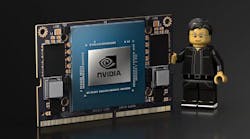Nvidia’s Jetson Nano (Fig. 1) has proven to be extremely popular in supporting machine-learning (ML) applications to the edge. The compact form factor (70 × 45 mm with a 260-pin edge connector) and low power requirements allow it to fit into drones, mobile devices, and an array of other low-power applications where artificial intelligence (AI) can a benefit. This can range from identifying objects in video streams from a surveillance system to obstacle avoidance in an automated delivery robot.
1. The Jetson XAVIER NX is pin-compatible with the original Jetson Nano.
The new Nvidia Jetson XAVIER NX (Fig. 2) is plug-compatible with the original Jetson Nano, but it brings the performance and functionality of the higher-end Jetson TX2. The six 64-bit Carmel Arm cores can all work with the 384 cores in the Nvidia Volta GPU. It also has a pair of Nvidia deep-learning accelerators (NDLA) that can be utilized. The system features 8 GB of 128-bit LPDDR4x DRAM and 16 GB of eMMC flash storage.
2. The Jetson XAVIER NX runs faster than its older sibling, the Jetson Nano, running on par with the larger Jetson TX2.
The Jetson XAVIER NX has plenty of power-management support as well as 800-MHz, 10-W and 1100-MHz, 15-W operating modes. The former allows a pair of CPU cores to run at 1.5 GHz or four at 1.2 GHz. The latter bumps the frequencies to 1.9 GHz and 1.4 GHz, respectively.
The newer module can handle a dozen MIPI CSI-2 D-PHY inputs for a total throughput of 30 Gb/s. This translates to half-a-dozen camera streams with up to 36 virtual channels. Video encode support tops out supporting a pair of 4K video streams at 30 frames/s.
The other peripheral support is similar to the Jetson Nano and the Jetson TX2. The Jetson XAVIER NX has a 1-Gb/s Ethernet port, PCIe Gen 3 x4 and x1, and HDMI 2 up to 2Kp50 or DPI 1.4 up to 4Kp120 or two eDP 1.4 4Kp120 channels. There’s a USB 3.0 port and a pair of USB 2.0 ports along with SDIO, SPI, UAR, I2C, I2S, CAN and GPIO ports.
The Jetson XAVIER NX doesn’t quite hit the performance of the higher-end Jetson AGX XAVIER. The latter delivers 32 TOPS using INT8, while the Jetson XAVIER NX comes in at 21 TOPS. Still, it’s extremely impressive performance given the compact form factor and power requirements.
The Jetson Nano was a popular target for carrier boards like the Gumstix Jetson Nano Development Board soon to be released by Gumstix (Fig. 3). It sports a pair of Raspberrry Pi vertical camera connectors as well as a Raspberry Pi-compatible 40-pin header. It also has an RJ-45 Ethernet jack, USB 3.0 port, an HDMI port and an M.2 Key E wireless card socket.
3. Gumstix does Nvidia one better on development boards by providing more camera inputs.
The Gumstix Jetson Nano Snapshot Board (Fig. 4) supports four Jetson modules, providing each with its own four-camera inputs. This type of carrier board targets embedded video applications.
4. The Gumstix Jetson Nano Snapshot Board targets embedded camera applications by hosting four modules each with four camera inputs.
AVerMedia’s EN713-AAE9-0000 carrier board (Fig. 5) targets end applications like video-surveillance systems. It includes an eight-port 10/100 Ethernet switch with power-over-Ethernet (PoE) support. The board also exposes the Gbit Ethernet power, and maintains two USB 3.0 ports and a 4Kp60 HDMI output. Other peripheral interfaces include a UART, two I2C ports, five GPIOs, a Micro-B USB 2.0 for recovery support, and a mPCIe socket with USB 2.0 support.
5. AVerMedia’s carrier board targets surveillance systems with PoE camera support.
The Jetson XAVIER NX and Jetson Nano provide a scalable, compact modular form factor that packs a lot of compute power tailored for AI inference applications. The Jetson Nano has been proven in this space, and the added performance that the Jetson XAVIER NX brings will only expand the capabilities and number of applications that can be addressed.
The other advantage of this family is that the company’s software support spans this family as well as the other Nvidia GPU-based hardware through the cloud-based cards and systems. As a result, applications can be moved easily from platform to platform, helping simplify development and deployment.







